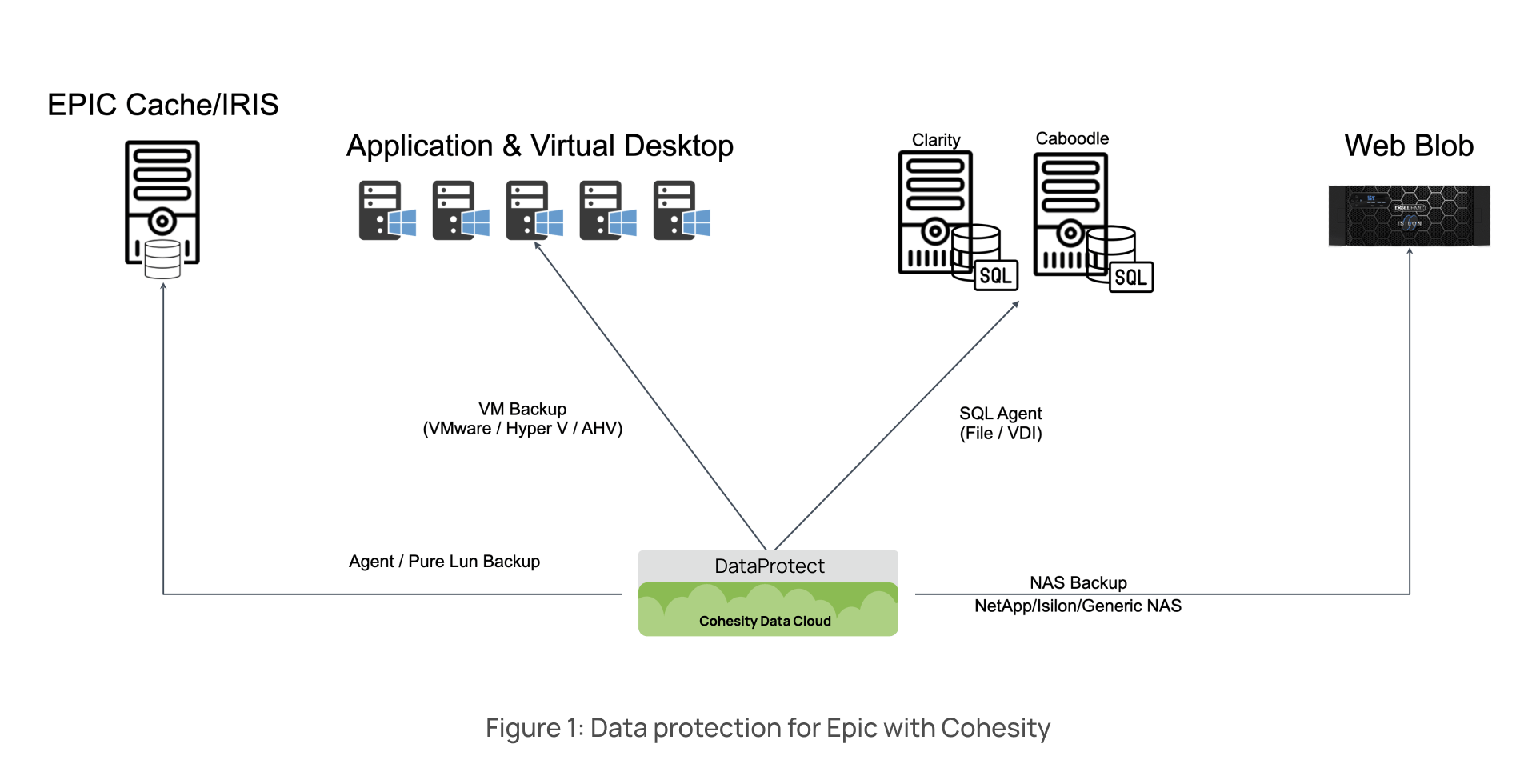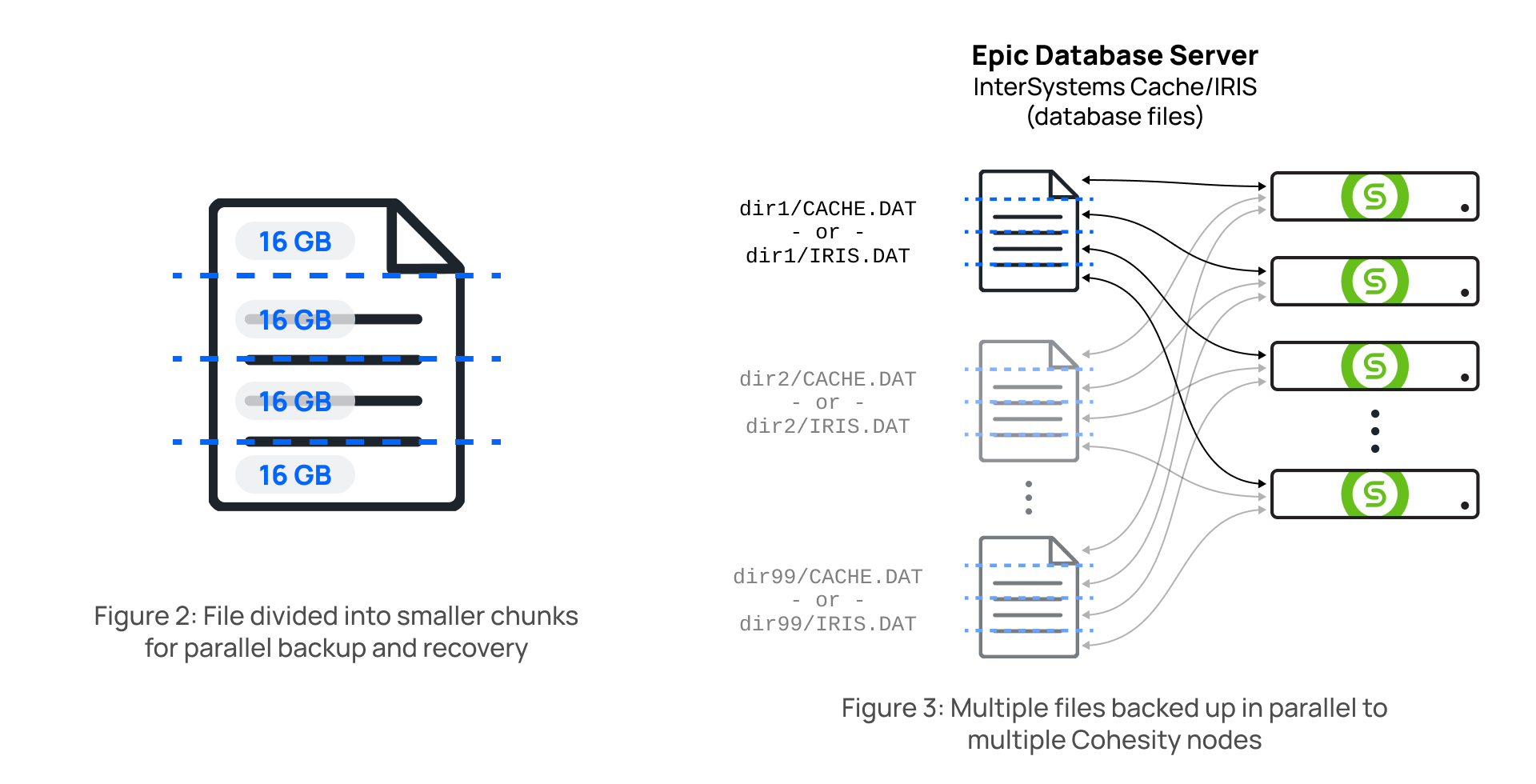In the dynamic landscape of healthcare and life sciences, where data security and management must be balanced, ensuring the efficiency and effectiveness of backup and recovery systems is paramount. Epic®, one of the leading providers of electronic health record (EHR) software, lies at the heart of many healthcare organizations, storing invaluable patient data and medical research information.
Considerations for evaluating backup and recovery solutions
To safeguard this critical data and ensure seamless operations, healthcare IT decision-makers must carefully consider the following ten essential factors when evaluating backup and recovery solutions for their Epic systems:
- High performance: Time is of the essence in healthcare, and any downtime can have serious implications. Opt for a backup and recovery solution that offers high performance, allowing for rapid backup and recovery processes to minimize disruption to patient care and operational workflows. Rapid access to accurate patient information is essential for delivering timely and effective care, making the speed and efficiency of backup and recovery processes critical.
- Immutability: Protecting data integrity is non-negotiable in healthcare. Choose a solution with immutability features that prevent unauthorized alteration or deletion of backup data, ensuring the integrity and reliability of your Epic system backups. The solution should have WORM-like protection so that your backups are immutable and cannot be tampered with by ransomware. Additionally, you should consider an air-gapped vault to ensure that a secondary copy of mission-critical data is kept off-site either in the public cloud, another data center, or on tape.
- Robust Zero Trust security: With the increasing frequency and sophistication of cyber threats, robust security measures are imperative. Look for a solution that employs a zero-trust security model, implementing stringent access controls, encryption, and authentication mechanisms to safeguard sensitive patient and medical data from unauthorized access or malicious activities. A modern solution helps you keep the bad actors at bay by identifying near real-time anomalies and exfiltration attacks, leveraging AI for threat detection and analytics.
- Industry compliance: Compliance with industry regulations such as HIPAA (Health Insurance Portability and Accountability Act) is essential for healthcare organizations. Select a backup and recovery solution that is compliant with relevant industry standards and regulations, ensuring that your data management practices adhere to legal requirements and best practices.
- Meeting Epic recommendations and requirements: Epic has specific recommendations and requirements for backup and recovery processes. Ensure that the solution you choose aligns with Epic’s guidelines to guarantee compatibility and optimal performance of your EHR system. Adhering to Epic’s guidelines minimizes the risk of data loss or corruption and facilitates interoperability and data exchange across different healthcare systems and providers, enhancing care coordination and patient outcomes.
- Comprehensive EHR backup and recovery: Beyond Epic, healthcare institutions rely on various other applications and systems to deliver quality patient care. Choose a backup and recovery solution that offers comprehensive support for backing up and recovering data from multiple sources, such as Epic Cache/IRIS, Clarity, Caboodle, web blob, etc., to ensure holistic data protection and continuity of operations. Always opt for a solution that allows you to recover many machines at a time, minimizing any potential downtimes due to a ransomware attack.
- Cost efficiency: Opt for a solution that employs efficient data reduction techniques to minimize storage requirements and reduce costs associated with backup and recovery. By deduplicating and compressing data before storage, you can significantly decrease storage overheads and achieve substantial cost savings over time. Additionally, a modern solution that uses global variable block level deduplication for greater efficiency can further optimize storage utilization and lower operational expenses, making your backup and recovery process more economical and sustainable in the long run. Look out for a solution that can dedupe Epic, Clarity, and Caboodle in one dedupe domain.
- ML-powered data classification: Use the power of machine learning (ML) to enhance data classification and identify potential security threats more effectively. Choose a backup and recovery solution that utilizes ML algorithms to analyze and classify data based on its sensitivity and importance, enabling proactive risk mitigation and targeted incident response. ML algorithms can identify potential security threats in real time by continuously analyzing data patterns and anomalies, allowing organizations to detect and respond to security incidents swiftly and effectively. This proactive approach helps prevent data breaches, mitigate the impact of security incidents, and strengthen overall cybersecurity resilience, safeguarding patient privacy and maintaining the integrity of critical healthcare data.
- Scalability and flexibility: Healthcare organizations constantly evolve, and their data management needs may change over time. Select a scalable and flexible backup and recovery solution that can adapt to growing data volumes, new regulatory requirements, and evolving IT infrastructure, ensuring long-term viability and agility in addressing emerging challenges. Always look for a solution that supports multiple storage vendors running popular EHR software packages, ensuring compatibility and interoperability with your existing infrastructure. As your organization grows and data volumes increase, the solution must adapt to the changing requirements without compromising performance or reliability.
- User-friendly interface and ease of management: An intuitive and user-friendly interface simplifies the complexities of backup and recovery operations. Look for a solution that offers centralized management capabilities, automation features, and comprehensive reporting tools to streamline administrative tasks and empower IT teams to manage and monitor backup processes efficiently. A unified platform for data management enables healthcare organizations to streamline backup workflows, reduce administrative overhead, and optimize resource utilization, ensuring uninterrupted access to critical patient information and mitigating the risk of data loss or downtime.
How Cohesity backs up and restores large files
Cohesity efficiently backs up and restores large Epic files with MegaFile. It’s a unique component of our architecture that allows fast backup and recovery for large files, using technology that intelligently distributes files across all nodes in a cluster. These large files might be 100s of gigabytes or 10s of terabytes or larger. Regardless of the file sizes, it helps reduce backup times and downtime when recovering from a disaster.
Cohesity helped Riverside Healthcare, a fully integrated healthcare system, significantly reduce Epic backup and restore times. Riverside now exceeds Epic’s backup SLAs, has more than 50 times data reduction, and has gained time savings of 70 percent for backup and restore.
Efficient backup and recovery of your Epic system is essential
Cohesity backup and recovery solutions align with best practices recommended by Epic for protecting EHR and EMR data, including using immutable backup technology to safeguard against ransomware attacks and ensure data integrity. We also maintain a comprehensive security certification program designed to protect our customers’ data confidentiality, integrity, and availability in accordance with industry, U.S. government, and international standards. Our products and services adhere to the security benchmarks and requirements aligned with HIPAA guidelines.
Efficient backup and recovery of your Epic system are essential for ensuring critical healthcare data’s integrity, availability, and security. By considering these 10 key factors and partnering with a trusted data management provider like Cohesity, healthcare, and life sciences organizations can enhance their cyber resilience, improve response and recovery capabilities, and safeguard the continuity of patient care and medical research initiatives.
Note: Epic is a trademark of Epic Systems Corporation and Epic is not affiliated with, and does not endorse products or services of, Cohesity.


















